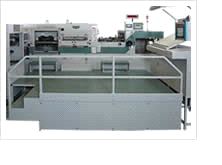Finishing & Screen Printing
Your Questions Answered on the Kluge V-Series Product Line

Monday 01. June 2009 - As you are aware, our line of vertical presses is relatively new to the printing and graphic arts industries. In light of this we have composed a list of the top FAQ's asked of our vertical product line.
The five most popular are answered in this article. However, there are 12 more available for your review. If you have a question that is not addressed here, feel free to contact us.
Note: Certain questions/answers are only applicable to a specific model i.e. DC, F or C. Similar options and configurations are available for the V-8 and V-13 models, contact Kluge to confirm availability.
1) What is the lightest stock that can be fed when the “Fine Paper Feeding” option is installed on the machine?
The fine paper feeding option utilizes a vacuum feed wheel system, to maintain registration on stocks that are lighter weight than those usually ran on the machine. With this option installed, we have successfully tested and ran stock as light as 60 gsm paper on the V-10 Series Press.
2) What is the minimum sheet size that can be fed into the machine with the “Small Sheet” attachment installed?
On a regular V-10 Series Press a sheet size as small as 14″ x 15″ (370 x 400 mm) can be fed into the machine. When you incorporate the “Small Sheet” attachment, a sheet as small as 11.8″ x 12.5″ (300 x 320 mm) can be fed. Note: The Small Sheet attachment cannot be retrofitted, it has to be requested with the machine with the press is ordered.
3) I noticed from a photograph that there appears to be a sensor at the head stop. Does the machine have an electronic sensor to recognize the presence of the sheet on the side and front lay?
Yes, there are front lay (head stop) and side guide sensors to monitor that the sheet is registered at the feeder, before the gripper grips the sheet. The sensors will either stop the feeder or sound a buzzer (if there is side guide error during foil stamping) in the event of a miss-fed or crooked fed sheet.
4) How is the impression strength adjusted on the Kluge V-10 Series Press?
On the V-10 DC Press, impression strength is adjusted using a hand wheel to change the pressure. A different method is required for the F and C models. In this case, impression strength is altered using UP/DOWN buttons. Once the correct pressure is achieved, the manual hand wheel should be rotated until it stops. The machine will now automatically adjust to this position on each impression. When the F and C models are set up for diecutting-only jobs, the hand wheel is solely used to make impression adjustments.
5) What is the dual air blast feature?
The dual air blast feature has two functions. The first air blast helps flatten the sheet as it enters the platen area. The second air blast helps separate the foil carrier from the foiled sheet. Air blasts are directed towards the platen through the air blast manifold located at the stock exit of the platen. The air blast consists of many nozzles which can be individually adjusted as well as two air regulators (one for each blast) which adjusts the pressure to all nozzles.
